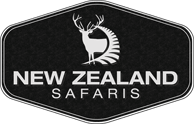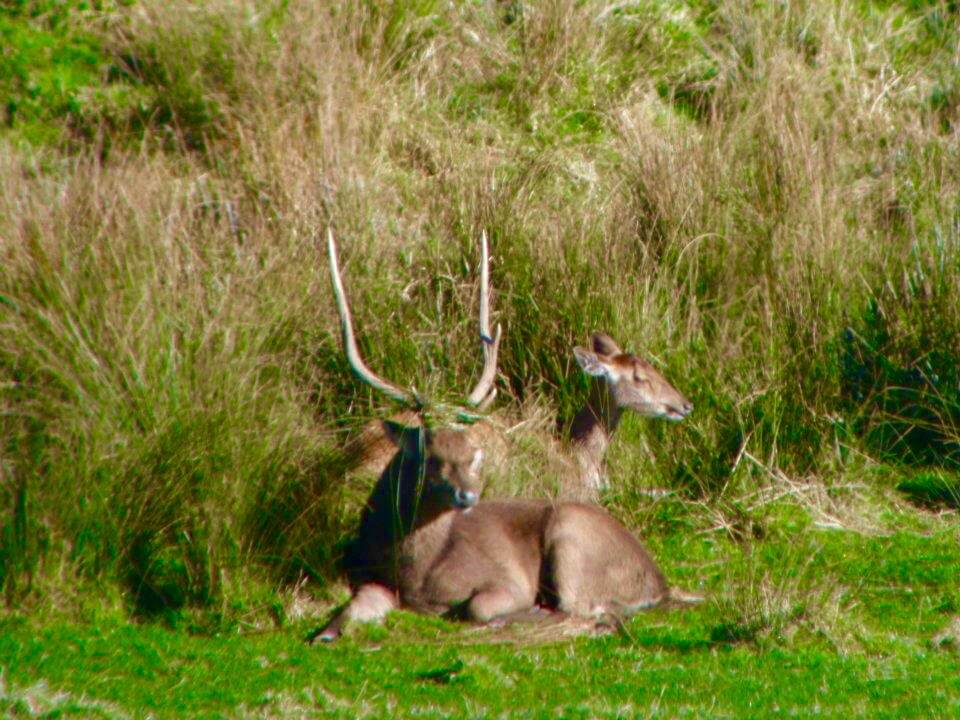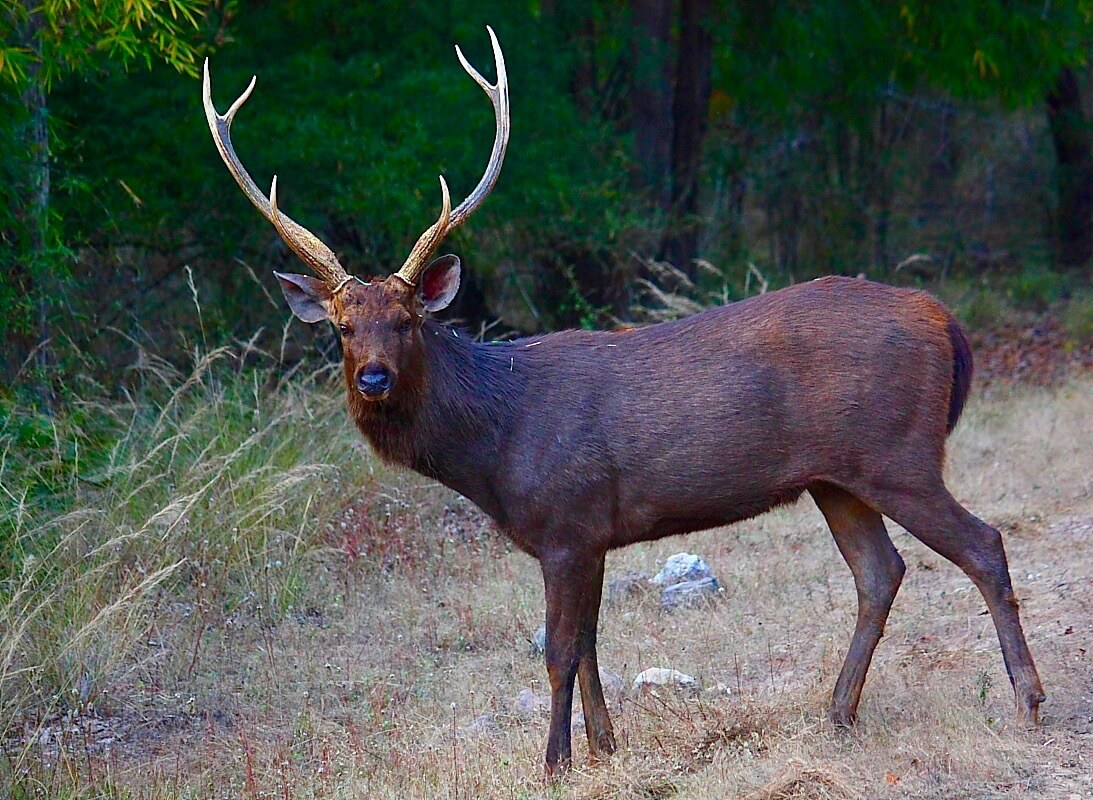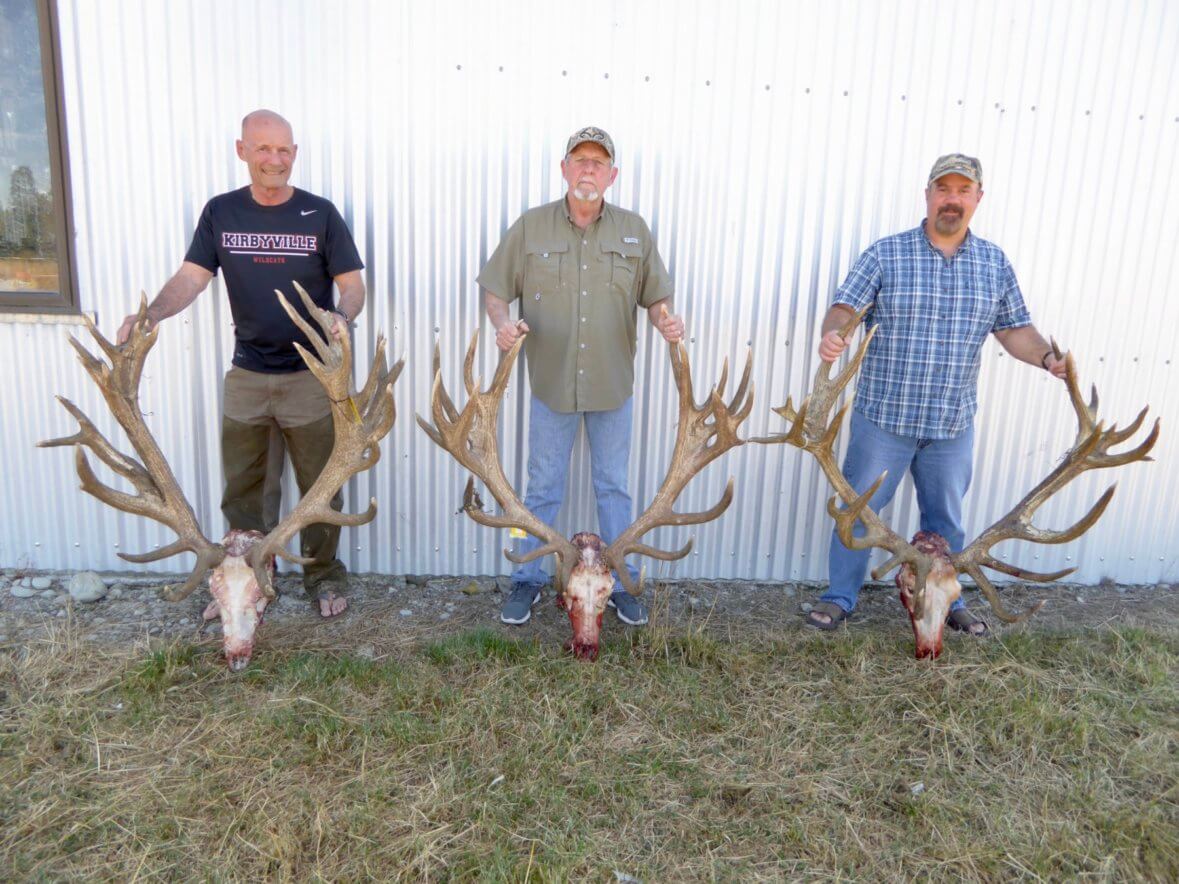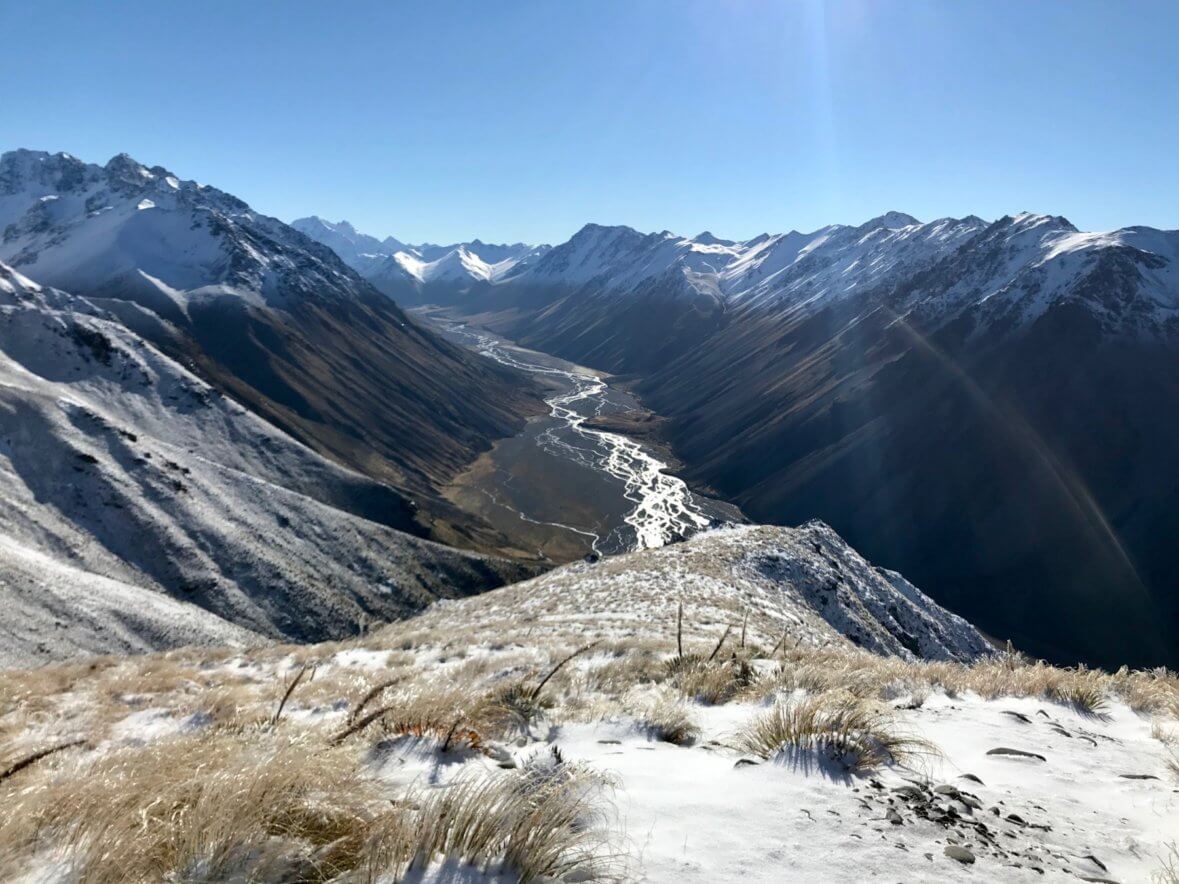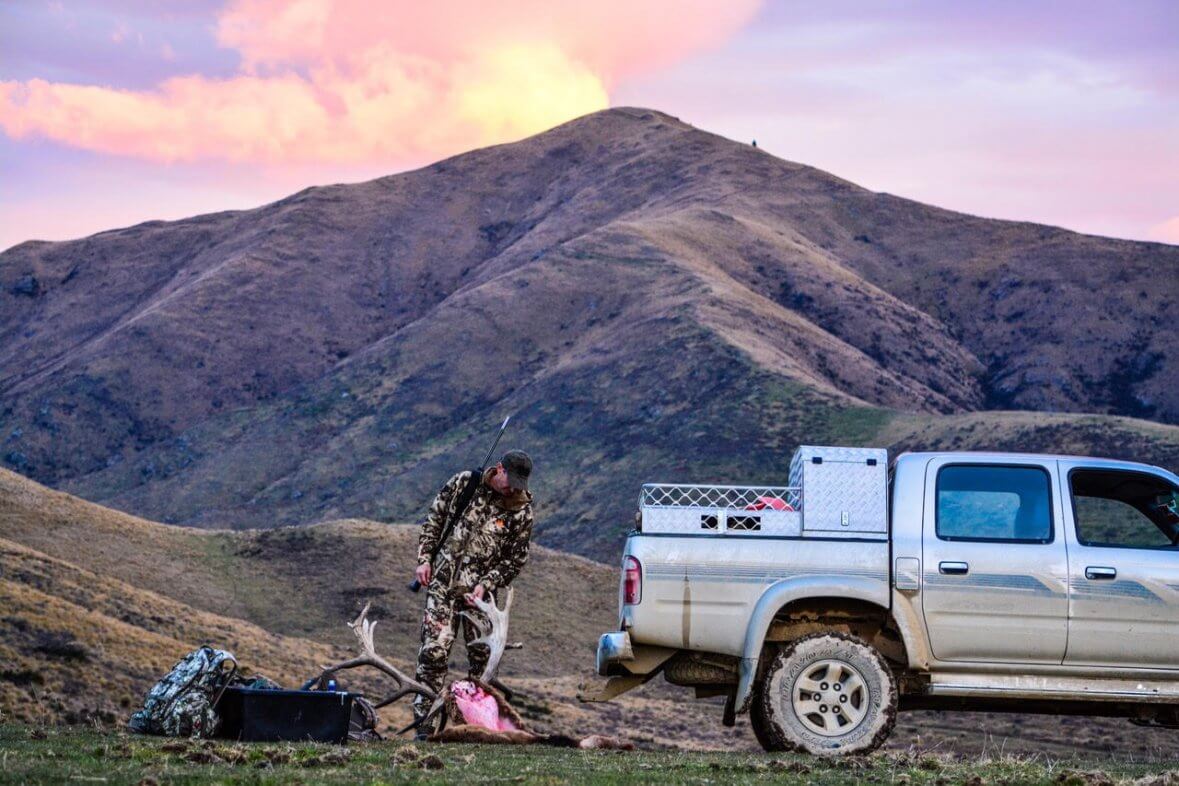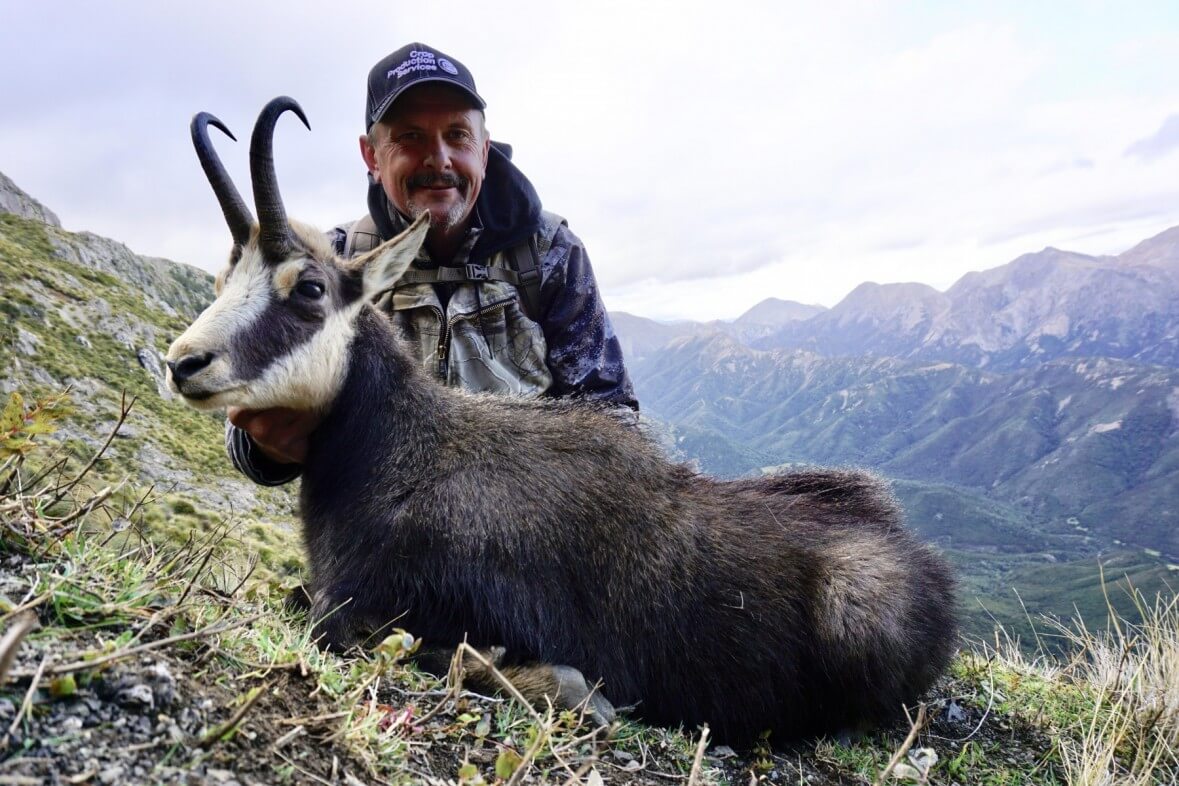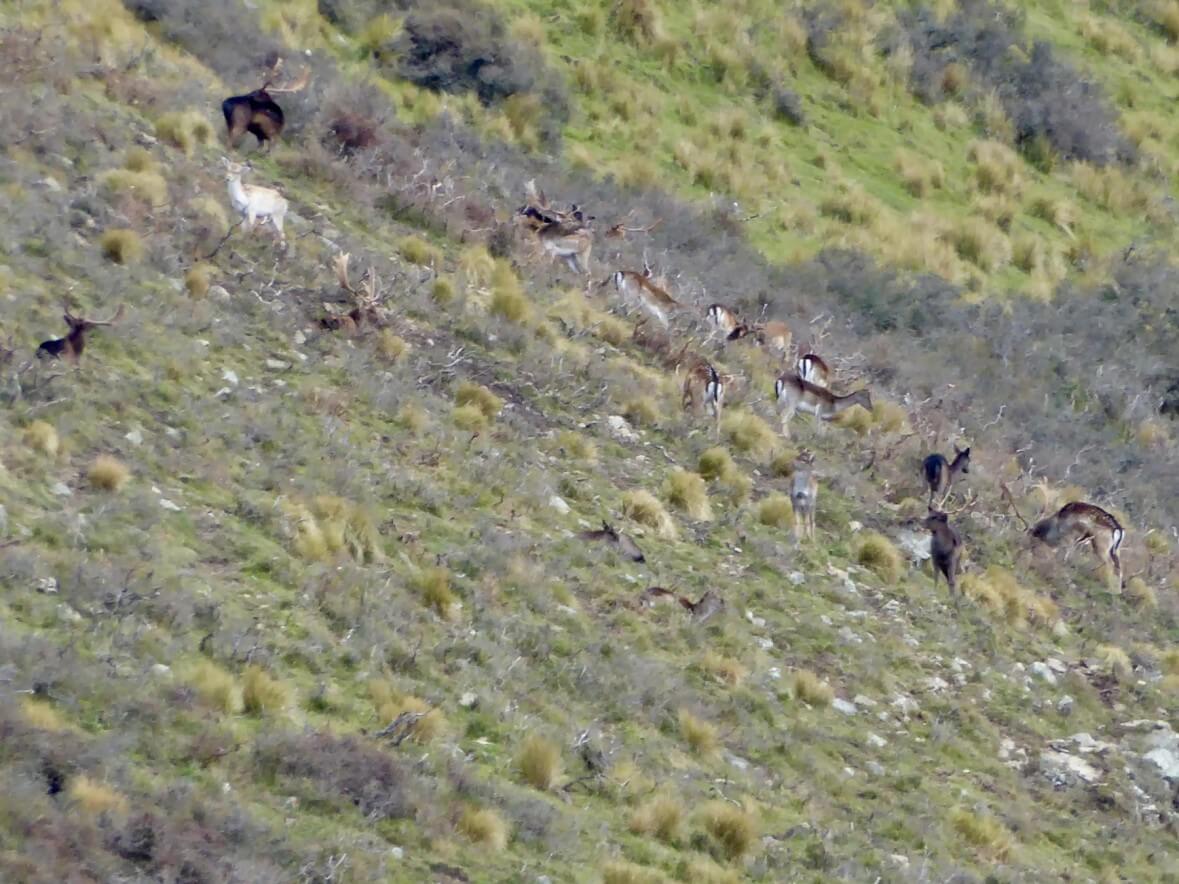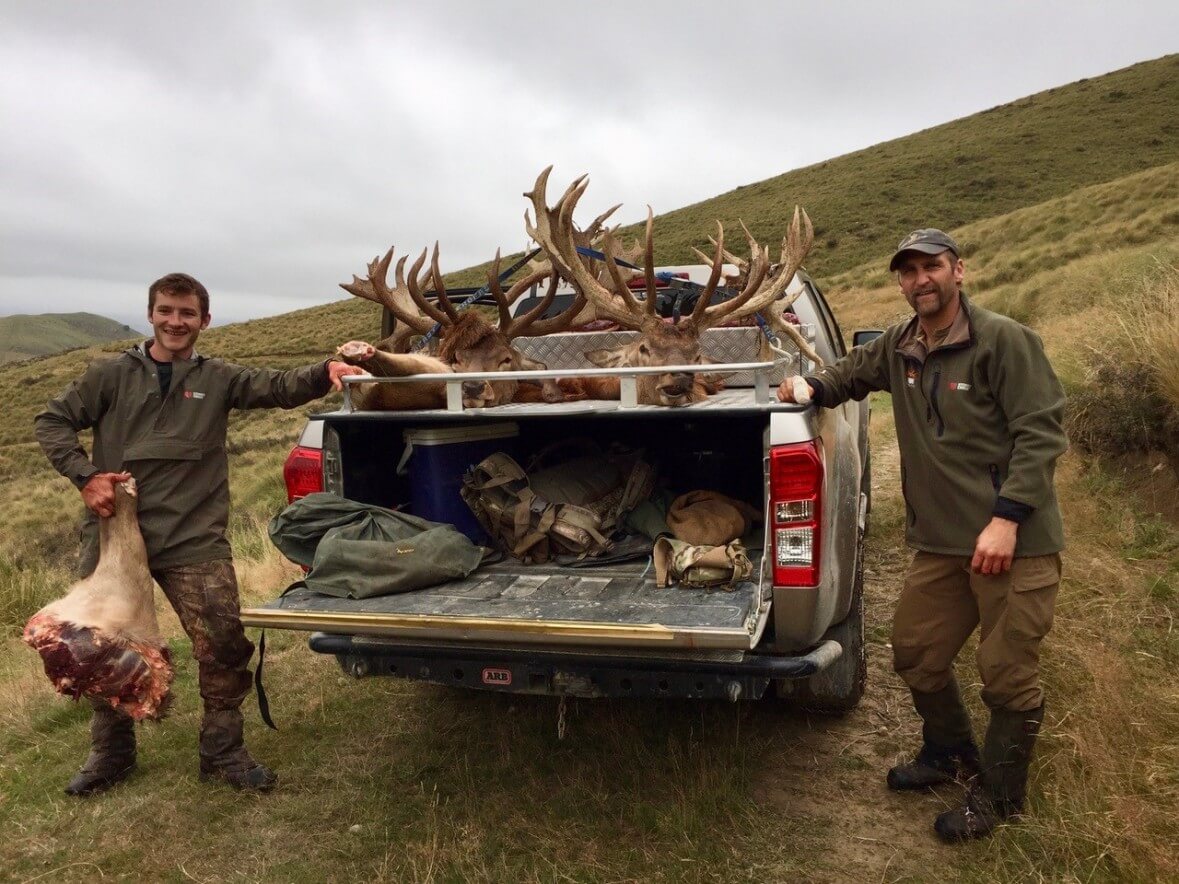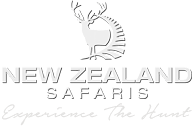A rusa deer (Rusa timorensis) is one of the most elusive deer to be found in the New Zealand bush. New Zealand Safaris offers rusa deer hunts in both New Zealand and Australia.
Description
Size: Male height is about 1060 mm at the shoulder and weighing 122 kg, females 810 mm shoulder height and weighing up to 70 kg.
Colour: Males dark reddish-brown summer coat changing to dark greyish-brown in autumn. Females pale yellowish-red in summer and greyish-red in winter. Chin, throat and underparts cream.
Antlers: Present in males only. Antlers cast December-January and new growth complete by May. Normally 3 points on each antler, with the inner tine longer than the outer and nearly parallel with the inner tine of the other antler.
Social behaviour: Wary and semi-nocturnal rusa spend much of the day holed up in thick vegetation cover. They live in small groups and have relatively small home ranges. Prefer mixed grass areas for feeding and often utilise adjacent farm paddocks and crops.
Reproduction: Rut commences mid-July and continues into August.
Males collect a harem of females. The actual male rusa’s roar could be described as a short husky growl rather than the drawn out bellow of a red stag. Males roar infrequently perhaps only 2-3 times a day with concentrated activity early morning and late afternoon.
Males wallow and mark their territory with scrapes. While servicing these scrapes, males leave an unmistakeable scent that could be described as a pungent sickly sweet aroma.
Gestation period: About 240 days.
Birthing: Fawns are born March – April. Twins rare.
Nomenclature: Male = stag. Female = hind. Young = fawn/calf.
Hunting Tips:
| Characteristics/behaviour | Hunting response |
|---|---|
| Rusa are a medium sized deer. | Rifle ccalibre of .270and above are suitable for shooting rusa deer. |
| Occupy areas of thick cover with warm aspect and adjacent to open grazing areas. | Seek out suitable habitat and either:Hunt very slowly, stopping often to look around as rusa are often very hard to see amongst dense vegetation.Stake out a warm clearing (especially in winter) and wait for a deer to come to feed, often involves a long shot. (Probably the more successful method.) |
| Semi-nocturnal and active mainly early morning and late afternoon, lay up in thick cover during much of the day. | Hunt or be at the stake out location early morning or late afternoon when deer likely to be more active. Rusa Stags rut from June-October. |
| Rusa are rarely encountered on their own. | When a rusa is sighted be alert as others may be in close proximity but hidden from view. |
| Sign of rusa includes a network of well used trails and tunnels connecting bedding sites with feeding areas. | Stake out areas where recently used tracking systems are found accessing feeding areas. |
In New Zealand, sambar deer (Cervus unicolor unicolor) are considered an ‘iconic herd’. They are only in the North Island and mostly on private land.
Sambar can be a difficult deer to hunt. As with all hunting the more you can learn about the quarry and the area to be hunted the better the chance of success.
Description:
Size: Males average 1370 mm shoulder height and 245 kg in weight with females smaller at 1150 mm shoulder height and weighing up to 157 kg.
Colour: Uniform brown darkening to almost black in older animals with tan to rust red on the rump. Under parts grey to mid brown.
Antlers: Thick, heavily pearled and normally three tined (brow and trez tines and a terminal tine at the end of the main beam). Antlers cast November to December with new ones grown January to March hardening between June and November.
Social behaviour: Males solitary except during the rut. Young males and females form small groups of 2-5 animals. Feed mainly at night and during the day seek shelter in scrub or forest cover. Form complex trail systems accessing feeding areas from day time cover
Reproduction: The rut can happen any time between late May and December with June to August the usual period. The females, attracted by noise and scent, visit the male for a short period until mating takes place. (Harems are not formed.) Males are not particularly vocal during the rut but are known to emit a short harsh belling noise which is rarely heard by hunters.
Gestation period: Approximately 240- 264 days.
Birthing: March-April or July-September.
Nomenclature: Male = stags. Female = hind. Young = fawn/calf.
Where to hunt
In New Zealand sambar deer are only found in the North Island.
The two main populations of wild sambar deer are found in the Manawatu/Wanganui region and the Bay of Plenty region. Their range in both these areas is mostly on private land – mainly forestry blocks. New Zealand Safaris has exclusive hunting access to some of the most sought after sambar deer properties in the country.
Sambar occupy a variety of habitats from indigenous and exotic forests to wetlands and farmland.
Hunting Tips:
| Characteristic/behaviour | Hunting response |
|---|---|
| Large bodied animals (mature stag 400-500 llb andstand 60+ inches at the shoulder) | A larger rifle calibre with high energy is recommended with Sambar Stags deer known to absorbed shots. Suitable calibers include .270, 7mm, 300 win. |
| Although tending to be unpredictable, within a hunting area sambar will have preferred spots for feeding, hiding etc. | Learning as much as you can about the area being hunted will greatly increase the chances of success. |
| Elusive animals with the ability to exit within close proximity to people without being detected. Often won’t break until a hunter is very close and sometimes crawl rather than run. Can hide in very small patches of vegetation. | Hunt slowly, stopping often and surveying all around. Don’t discount the smallest of vegetation patches eg small clumps of gorse. |
| Once spooked sambar usually won’t go far and as retreating can often be heard making a trumpet like noise. | Listen to retreating animal to gauge where it is heading and after a short time follow. |
| Sambar feed primarily early morning and late evening utilising the cover of darkness but can be found feeding during the day using vegetation cover. | Late evening and early morning hunting is likely to find deer out in the open where as day time hunting will likely find deer in amongst thick vegetation. Hunt the change of light on dark nights. |
| Sambar are attracted to crops for feeding. | New Zealand Safaris hunts exclusively on private free ranging land like that has this feed. |
| Sambar Deer Rut New Zealand | Sambar deer’s main rut is from late May-September, and at times longer. |
| Sambar are very alert to foreign sounds. | With the wind in the right direction stake out feedings areas and wait for sambar to come to you. |
One of the most common questions we hear is, how much is a red stag hunt in New Zealand? There are lots of factors that will effect the price of a red stag hunt – public or private land, professional outfitter or DIY, size of the animal, accommodations to name a few. Most Red Stag hunts with professional outfitters will start around USD $5500 per hunter in 2 hunters x 1 guide. This will often include 5 days of hunting, 4 nights of accommodation and trophy fees for 1 Red Stag up to 350 inches or 1 wild and free range Red Stag.
So how much is a red stag hunt at At New Zealand Safaris? Our base Red Stag hunts starts at $5500 which is conducted all on privately owned land, where we have exclusive hunting rights.
As you research you will find Red Stag hunt prices in New Zealand can vary depending on the hunting outfitter and quality and experience of the hunt someone is looking for.
If you are interested in larger stags or combination packages please contact us.
About one third of the total land area in New Zealand is public land, that mostly can be hunted. When hunting on public land you will need to have a D.O.C permit, and a New Zealand Firearms permit. A lot of the public hunting areas in New Zealand has no management or restrictions at all, which means the animals can be and are hunted year round. Over the years, this lack of management has affected the quality of trophy heads, the habitat, and characteristics of the animals. Most often we see these animals becoming nocturnal and very spooky. You will especially notice the differences within the red deer population. A red deer taken on public land usually has a noticeable difference and lack in quality compared to that of private land hunting.
So where can you hunt in New Zealand? Some of the animals are only in one island, or will only be within certain areas of the islands. It is important to figure out exactly what species you are after and then you can figure out exactly where in New Zealand you should be hunting according to the species you are after,
North Island Species
In the North Island species to hunt are predominantly deer; Red deer, Sika deer, Sambar deer, Fallow deer, Rusa deer. You will also find Goats, and birds.
South Island Species
In the South Island species to hunt are Red deer, Fallow deer, Elk, Whitetail deer, Tahr, Chamois, Wild Ram, Alpine Goat, Wallaby, and birds. Again many of these species are more prominent in some areas. For example, Tahr, which are mainly in the central South Island near Mt Cook.
New Zealand Safaris offers free range and fair chase hunting opportunities. Our lodge is located in the South Island but we arrange hunting safaris in the South Island, North Island and Australia. If you are considering taking a hunting trip to New Zealand investigate all of your options before determining where to hunt in New Zealand.
Like many of the deer species the lungs and heart are in the lower quarter of the Red Stag, approximately the size of a dinner plate.
For Red Stag shot placement judging half way going from the top of the shoulder and bottom of the chest you should aim slightly under half way. Being more of a medium skinned animal Red Stags like all animals can be extremely tough during the rut to take down so use appropriate calibers again that deliver good kinetic energy and you can handle to shoot accurately. Muzzle breaks or preferably suppressors are excellent options if you’re worried about recoil and the latter noise. All of our New Zealand Safaris rifles are equipped with suppressors.
A suitable range between 80-250 yards and take time to make the shot. Bow hunting on these guys will get your heart pumping with average shots at approximately 40 yards where we can use cover, calling, and blinds to get in close.
When discussing red stag shot placement, we are typically aiming for double lung, braking both shoulders and potentially also hitting heart which would be the ideal shot. As every hunter knows animals do not always stand square on at 90% and waiting for the perfect alignment can mean not getting a shot.
First and foremost if you are not confident with taking a shot don’t take it. It’s not worth pointing your rifle and shooting or ball parking it. Preparation before the shot and knowing where the vitals are is important in making sure you are taking an ethical shot. With a steady rest you can make those quartering shots if need be. Stags will often turn to face you if they have been alerted or winded you for a brief moment, it may be your best opportunity. Preparation really equals opportunity.
When lining up red stag shot placement it’s always important to think about bullet exit over entry as this is where maximum damage occurs so look at where the off set leg is positioned and body. Front on low down and allow for the exit. Another fatal shot that can be taken if you are very confident and your rifle is a tack driver is at the base of the neck and the spine.
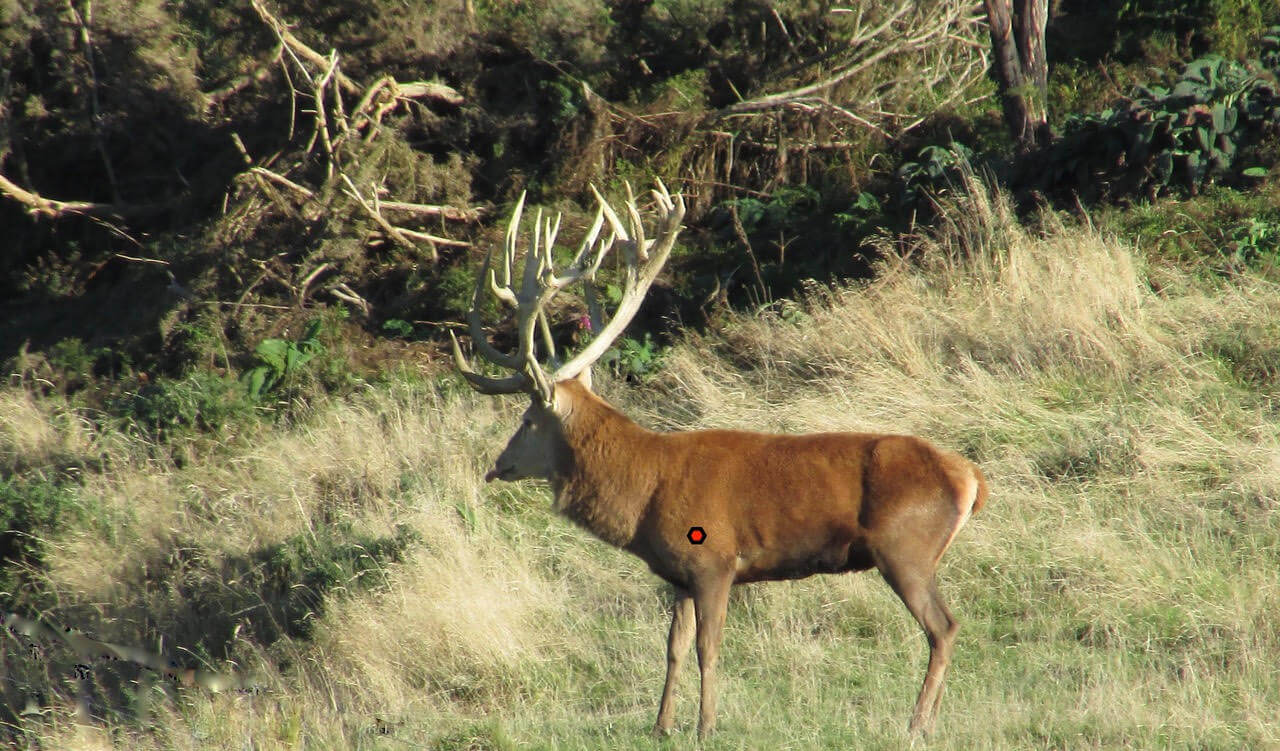
There are 11 big game New Zealand animals to hunt, 4 varmints, and a variety of birds including turkey and ducks. Due to a lack of management on government land, the trophy animals are typically much larger and older on private land because of the lack of hunting pressure, improved genetics and food quality.
May is the beginning of the chamois rut, and our chamois first foot hunter of the year has arrived from Idaho, USA.
Fallow bucks are in full rut (croak) now in April. Deer hunting for fallow bucks is different than any other deer species in the world. The fallow bucks will have their own rut pad or a communal one and the females or does will come into these pads to get mated.
There are many differing opinions from hunters and Outfitters regarding taking meat back into the United States from hunted animals. There are a 2 steps you must follow but basically yes you can do it without any problems.
(more…)
Last December, I was interviewed by the crew at the Sportsman of Colorado Radio Show in the lead up to the International Sportsman’s Expo. Have a listen! (more…)
- 1
- 2
